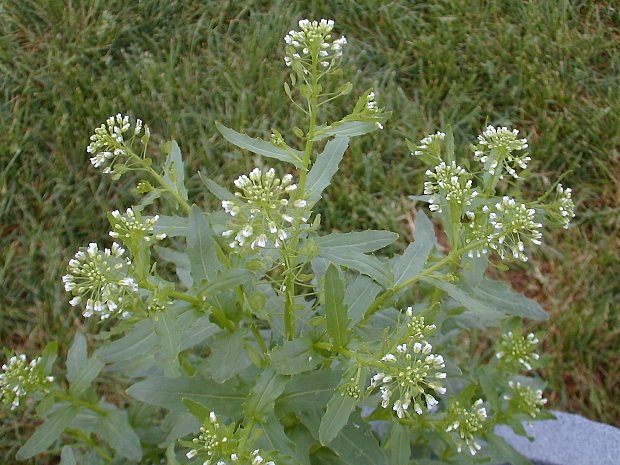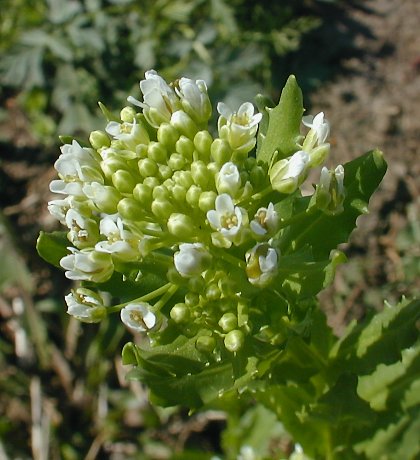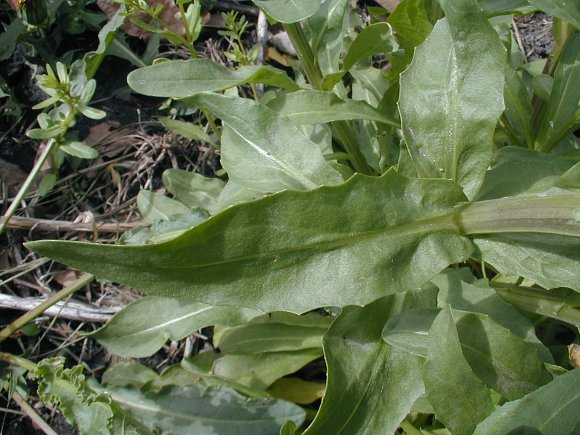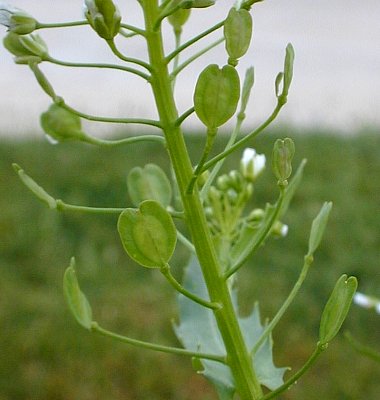Description: This winter or summer annual is about 1–2½' tall, branching occasionally. Plants that are winter annuals form a rosette of leaves up to 6" across. These leaves are oblanceolate or obovate and have long petioles. Summer annuals and 2nd-year winter annuals develop a central stem and several side stems. These stems are glabrous, ribbed, and winged along some of the ribs. The hairless alternate leaves are up to 4" long and 1" across. They are lanceolate, oblanceolate, or narrowly ovate, and have slightly wavy margins with a few blunt teeth. The lower leaves have short petioles or they are sessile, while the middle to upper leaves clasp the stem. At the base of each middle or upper leaf, there is a pair of ear-like lobes that clasp the stem and taper to a blunt point. Both the central stem and upper side stems terminate in erect racemes of small white flowers. Initially, the flowers bloom near the apex of a raceme, which later lengthens to about 3-8" as it matures.

Each flower is about 1/8" (3 mm.) across when it is fully open, and it has 4 white petals and 4 green sepals. The slender pedicel of each flower is up to ½" long. The blooming period usually occurs from late spring to mid-summer, and lasts 1-2 months for a colony of plants. A few plants that are summer annuals may bloom later in the year. There is no noticeable floral scent, although the foliage may have a mustard-garlic aroma. Each flower is replaced by a seedpod up to ½" long and across that is nearly orbicular (a silicle). This seedpod has 2 cells, each containing several seeds, which are surrounded by a wide membranous wing. There is a small notch at the top of each seedpod. The seedpods are held more or less erect relative to the raceme. They eventually become detached from the raceme, and blow about in the wind. Each dark brown seed is oval-shaped, but well-rounded on one end and tapering to a point on the other. Across its surface there are curved concentric ridges that resemble the patterns of a fingerprint. The root system consists of a taproot. This plant spreads by reseeding itself.

Cultivation:
Full
sun, mesic levels of moisture, and a fertile loam or clay-loam are
typical growing conditions for this plant.
Range & Habitat:
The non-native Field Pennycress is a common plant that occurs in most
areas of
Illinois (see Distribution
Map). It is adventive from Eurasia. Habitats include
cropland, fallow fields, areas along roadsides and railroads, gardens
and nursery plots, weedy meadows, and waste areas. This plant prefers
disturbed areas, and its capacity to invade higher quality natural
habitats is low. This is a common agricultural weed.

Faunal
Associations:
The nectar of the flowers attracts primarily small bees and flies. The
caterpillars of some White butterflies and Pyralid moths probably feed
on the foliage, including Pieris rapae (Cabbage
White), Pontia protodice (Checkered White), Eustixia
pupula (Pyralid Moth sp.), and Evergestis pallidata
(Purple-Backed Cabbageworm Moth). Mourning Doves occasionally eat the
seeds of weedy members of the Mustard family. Because the foliage has a
bitter-garlic flavor, it is not a preferred food source for mammalian
herbivores. When dairy cattle eat this plant, their milk develops an
off-flavor.
Photographic Location:
The photographed plants were located in a large flower pot at the
webmaster's apartment complex in Urbana, Illinois, and in an
agricultural field within the same city.

Comments: The most distinctive characteristic of Field Pennycress is the large size of the coin-shaped seedpods (at least 1/3" long when mature). Other members of the Mustard family have seedpods that are long and slender, or their seedpods are flat and round like Field Pennycress, but smaller in size. The other species in this genus that occurs in Illinois, Thlaspi perfoliatum (Perfoliate Pennycress), is a less common plant with smaller seedpods (about ¼" long) that are more oval in shape. For this species, the ear-like lobes at the base of the middle and upper leaves are well-rounded, while the same lobes of Field Pennycress are more acute, each tapering to a blunt point.